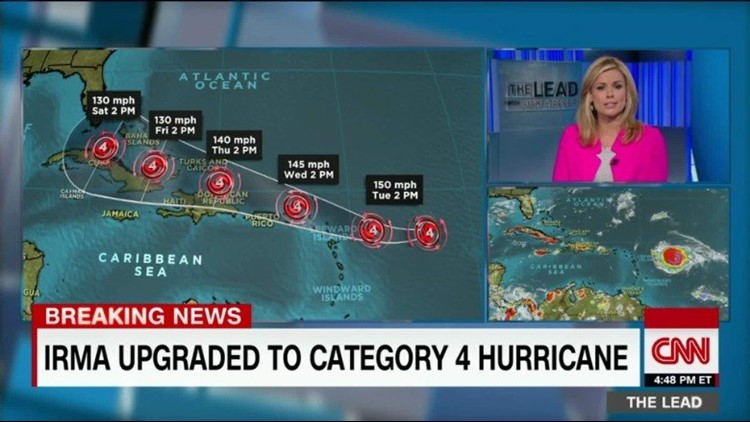(CNN) — Hurricane Irma, which has strengthened to a Category 4 storm, is expected to slam the Caribbean and possibly the US mainland this week.
The increasingly menacing storm would continue churning west in the Atlantic Ocean Tuesday and meteorologists say Puerto Rico and other Caribbean islands could begin to see its wrath by the end of the day, according to the National Hurricane Center.
As of 5 a.m. ET, the “dangerous major hurricane,” was about 320 miles (515 kilometers) east of the Leeward Islands, the National Hurricane Center said. It is packing maximum sustained winds of 150 mph (240 kph) as it heads west at 14 mph (22 kph).
Landfall is expected early Wednesday on the island of Anguilla, the hurricane center said.
Computer models show the system swirling toward the Caribbean, and by the end of week, it will turn right toward the north, said CNN meteorologist and weather anchor Pedram Javaheri.
While Irma’s exact path is still uncertain, several islands in the Caribbean as well as Florida are bracing for the storm.
After declaring a state of emergency all across Florida, Gov. Rick Scott said President Donald Trump had “offered the full resources of the federal government as Floridians prepare for Hurricane Irma.”
“In Florida, we always prepare for the worst and hope for the best, and while the exact path of Irma is not absolutely known at this time, we cannot afford to not be prepared,” Scott said in a statement.
Puerto Rico
Hundreds of people rushed to the stores, emptying shelves of food and drinking water just as the governor of Puerto Rico, Ricardo Rosselló, declared a state of emergency and activated the National Guard on Monday.
For hours, people also lined up outside hardware stores hoping to get plywood, batteries and power generators. If Irma knocks out power, Puerto Ricans said they are worried it would take weeks or months before the power is restored.
“It (power) is something absolutely necessary, especially due to Puerto Rico’s weather. We need to have the A/C or a fan on all night,” a woman told CNN affiliate WAPA.
Last month, the director of Puerto Rico’s power utility Ricardo Ramos Rodríguez, said several factors have made the island’s electric system “vulnerable and fragile,” WAPA reported.
One of those factors is the shortage of employees. Many workers recently retired or left their jobs for better prospects in the US mainland, Ramos Rodríguez said.
Public schools and officials at the University of Puerto Rico campuses have canceled classes, and many businesses remain closed.
Puerto Rico and a string of Caribbean islands are under hurricane warnings, including the British and US Virgin Islands, Antigua, Barbuda, Anguilla, Montserrat, St. Kitts, Nevis, Saba, St. Eustatius, St. Martin/Sint Maarten and St. Barts, the hurricane center said.
The warnings are usually issued to areas that could see “tropical-storm-force winds” of up to 140 mph in about 36 hours after the alert goes into effect.
“Make a U-turn and die in the ocean, Irma. The Caribbean islands don’t need more problems!,” Twitter user mujertropical wrote about the storm.
‘Better safe than sorry’
By the weekend, it’s possible that Irma could start heading to the eastern coast of Florida and also farther up the East Coast, Javaheri said.
“Everyone wants to see this at least meander away from the United States. The strength, the positioning, the timing of that troughs coming in to the eastern coast line will dictate exactly where Irma ends up,” Javaheri said.
In Miami, supermarkets are already selling out on water and non-perishable food. People are trying to beat the rush in case Irma makes landfall in Florida.
“I’ve been through hurricanes and they’re like ‘oh it’s going to hit right here’ and then it hits 30, 40 miles up the coast and it kind of changes the way everything goes so, better safe than sorry,” Florida resident Greg Andrews told CNN affiliate WPLG.
Why Irma could be especially intense
Irma is a classic “Cape Verde hurricane,” meaning it formed in the far eastern Atlantic, near the Cape Verde Islands (now known as the Cabo Verde Islands), before tracking all the way across the Atlantic, CNN meteorologist Brandon Miller said.
And Cape Verde storms frequently become some of the largest and most intense hurricanes. Examples include Hurricane Hugo, Hurricane Floyd and Hurricane Ivan.



